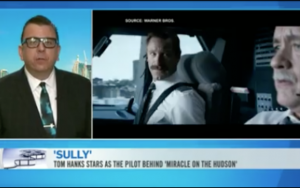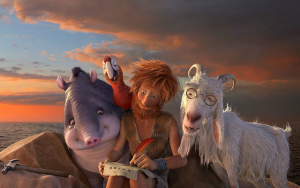CTV NEWSCHANNEL: Richard talks about meeting the real life Sully
 Richard speaks to CTV NewsChannel anchor Jennifer Burke about meeting the real life inspiration for the movie “Sully.”
Richard speaks to CTV NewsChannel anchor Jennifer Burke about meeting the real life inspiration for the movie “Sully.”
Watch the whole thing HERE!
 Richard speaks to CTV NewsChannel anchor Jennifer Burke about meeting the real life inspiration for the movie “Sully.”
Richard speaks to CTV NewsChannel anchor Jennifer Burke about meeting the real life inspiration for the movie “Sully.”
Watch the whole thing HERE!
 By Richard Crouse – Metro Canada
By Richard Crouse – Metro Canada
On January 15, 2009 Sully Sullenberger was an airplane captain with forty-two years experience piloting a plane on a routine run from New York’s LaGuardia Airport to a stopover at Charlotte Douglas International Airport. The next day he was a worldwide hero, an instant celebrity.
Shortly after take-off his plane was disabled by a flock of Canadian Geese who flew into the engines, knocking out the plane’s navigating system. In just under four minutes Sullenberger assessed the situation and, realizing there was no time to turn back, made the decision to land the craft on the Hudson River. The risky landing was successful and all 155 passengers and crew survived with only minor injuries.
To this day the now-retired pilot says when he flies “other passengers often tell me, ‘I feel so much safer now that you’re on the airplane with us.’ I’m not quite sure why they do, but I’m just glad they do.”
The Miracle on the Hudson, as the New York press dubbed it, is now the subject of Sully, a biopic from director Clint Eastwood and star Tom Hanks.
The pilot says, “Watching the film, especially in the IMAX format makes you feel like you’re on that flight with us,” but doesn’t bring back the anxiety of the day for him.
“Enough time has passed,” he says, “and I’ve had enough time to process this and make it a part of me and not something that just happened to me. I don’t have quite the same emotions I had during that day, that flight, but the very first time I saw this film with my family it was a very emotional experience for all of us. The second time I watched the film I was able to take it in as more of a usual movie going experience and see some of the things I wasn’t able to see the first time.”
As for having Oscar winner Hanks portraying him Sullenberger says, “We talked in some detail about the script and the obligation he felt to get it right because after the film was completed I would be going back to living my life and would have to live with however he portrayed me on screen.”
Now that the movie is finished he laughs, “It is a weird experience to see someone else onscreen portraying you and speaking words you actually spoke.”
Sullenberger’s story doesn’t end with the landing. In the years since he has been named one of Time magazine’s 100 Most Influential Heroes and Icons, written bestselling books and become a spokesman for St. Jude Children’s Research Hospital. It’s a whirlwind that changed his life forever.
“My family and I think of this story in two phases. There was the trauma of that flight itself and then the trauma of suddenly becoming a world recognized public figure. Once my name had been discovered by the press an onslaught, a tsunami of attention happened very quickly. Within a few months we had received 50,000 communications. Emails, letters, requests. The press was camped outside our house for ten days. It was just overwhelming. It very quickly required finding a new way of living this life as public figures. We had to become more complete versions of ourselves to be able to do that.”
“Life is easier in the air,” sighs First Officer Jeff Skiles (Aaron Eckhart). Easy? Not when the plane you are piloting is subject to a bird strike that disables two of the engines. That’s the story told in “Sully,” Clint Eastwood’s real-life account of ‘Sully’ Sullenberger’s miraculous landing of a disabled plane on New York’s Hudson River.
Tom Hanks plays the title character, a pilot with 42 years experience. “It’s been my life,” he says of aviation, “my whole life.” January 15, 2009 started off as a routine day for the seasoned pilot. As the captain of US Airways Flight 1549 he left New York’s LaGuardia Airport for a stopover at Charlotte Douglas International Airport when his plane was disabled by a flock of birds who flew into the engines, knocking out the plane’s navigating system. In just under four minutes Sully assessed the situation and, realizing there was no time to turn back, made the decision to land the craft on the Hudson River. “I’ve delivered one million passengers over 40 years,” he says later, “but will be charged on 208 seconds.” The risky landing was successful and all 155 passengers and crew survived with only minor injuries. “It’s been a while since New York had news this good,” says one airline official, “particularly with an airplane in it.”
The film dramatizes the landing but spends most of its time in the aftermath, the resultant onslaught of publicity and some very difficult questions from a National Transport Safety Board investigative panel.
“Sully” is a slight but entertaining movie. Because we know how it ends Eastwood’s attempts to create tension by and large don’t work. Its you-are-there recreation of the landing is exciting when it places the viewer in the plummeting metal tube—the mantra “Brace for impact” will forever be branded on your brain—melodramatic when it hits the water. It’s the centerpiece of an otherwise movie talky movie.
The ditching of the plane may get your pulse racing but it is the personal story that will stay with you. As Sully Hanks is dignity personified. Questions gnaw at him in the days leading up to the inquiry, causing sleepless nights and mild friction with his wife Lorraine (Laura Linney) but he remains steadfast. It’s old school heroism and it looks good on Hanks.
As a function of the story, but also, I suspect, as a preference of the filmmaker, technology is downplayed throughout. When the NTSB uses computer simulations to attack Sully, Skiles, who has most of the good lines in the film, says, “They’re playing Pac-Man while we’re the ones flying the plane.” The point being made is that computers lack the human touch but it does feel a bit like Grandpa complaining that the new fangled television remote is too complicated.
“Sully” is a well-constructed, occasionally exciting old-fashioned story of heroism in the face of modern cynicism.
 By Richard Crouse – In Focus
By Richard Crouse – In Focus
Broad vocabulary, grammar and syntax are the domain of humans, but science tells us millions of species communicate by using body language and intuitive calls. Chimps can be taught to sign simple phrases and elephants have individual sounds to signify danger and emotions, but complex storytelling is left to us humans.
Unless you’re at the movies. This year, theatres have been overrun by hordes of anthropomorphic animals. From Zootopia and Nine Lives to The Secret Lives of Pets and The Jungle Book, animals have been talking up a storm.
This weekend The Wild Life becomes the latest animated film to tell a story from the point of view of wildlife. A riff on Daniel Defoe’s classic tale of survival, Robinson Crusoe, the film’s narrator is a bright red parrot named Mak (David Howard).
In this version, Crusoe crash lands on an island where animals rule and must work with the chatty Mak, a tapir named Rosie and Kiki the kingfisher to save their home from an invasion by some savage felines.
Disney has the grandest tradition of talking animals — Mickey Mouse to The Little Mermaid’s Sebastian the Crab and Jiminy Cricket to name just a few — but they are not the only ones putting words into our pet’s mouths.
Flushed Away comes from Aardman, the animation company behind Wallace and Gromit.
The story of an upper class pet mouse flushed down the loo by a bullying rat features great animation, an all-star British voice cast and something that all kids love — toilet humour. It swirls along at quite a clip, effortlessly mixing literate verbal and visual jokes — we glimpse a cockroach reading Kafka’s Metamorphosis — with potty humour that’ll appeal to the kids.
G-Force’s talking crime fighting guinea pigs come courtesy of über-producer Jerry Bruckheimer. The voice cast includes not one, but two Oscar winners, which may be an indication that the recession has finally taken root in Hollywood.
When the best gig Penelope Cruz can get involves saying lines like “Oh, I have to save his fur again?” you know times are tight for A-listers.
Pixar’s Ratatouille is an unusual cross between America’s Next Top Chef and Willard. Remy (voiced by Patton Oswalt) is a sophisticated rodent with a highly developed sense of smell and a wicked sense of humour.
While his rat brothers and sisters are happy to simply survive by scavenging through the garbage, Remy aspires to culinary greatness. Ratatouille does something no other film has been able to — not that a lot of have tried — it makes rats cute, lovable even.
On the live action front, Zookeeper, or as any Kevin James movie could be called, “Fat Guy Falling Down… A Lot,” plays like Dr. Doolittle if Dr. Doolittle was a romantic comedy for kids. Luckily the animals come to the rescue. Luckily the monkey from The Hangover 2 has some of the film’s best lines. Adam Sandler provides the monkey voice, but also listen for the beastly vocal work of Cher, Nick Nolte, Don Rickles and Sylvester Stallone.